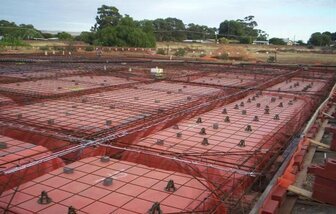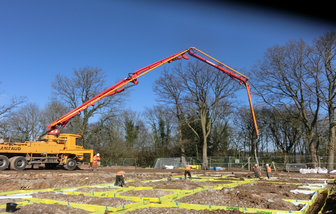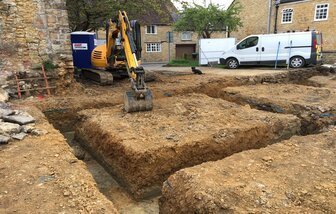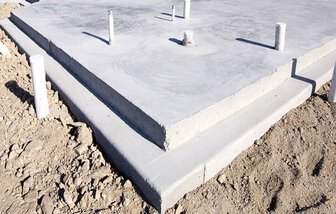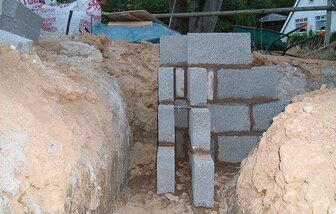How long to leave the foundations of a building before you start building
Learn about the importance of foundation curing time in construction. Discover how long it takes for a foundation to cure and the factors that affect the curing process. Proper curing ensures the strength, stability, and longevity of the foundation. Find expert guidance for foundation construction in the UK.
Understanding the Importance of Foundation Curing Time
Understanding the importance of construction base curing time is essential for any construction company in the UK, especially when working with concrete bases.
Before building foundations are poured, a thorough understanding of the type of footings required, the ground profile, and loads of the building is necessary. The landscaping process must be deep enough, with stable ground and proper drainage.
A step-by-step guide is required, starting with marking lines to indicate where to dig the foundations trenches. After landscaping, shuttering, reinforced with timber, must be used to create, and form a right-angled slab.
Once the construction base is filled with concrete, building regulations will need to inspect and ensure that the pouting of the concrete is done correctly, and the base is level using a spirit level.
The duration required for the concrete to attain its full strength and stability can be affected by external factors like clay soil, moisture, and temperature fluctuations.
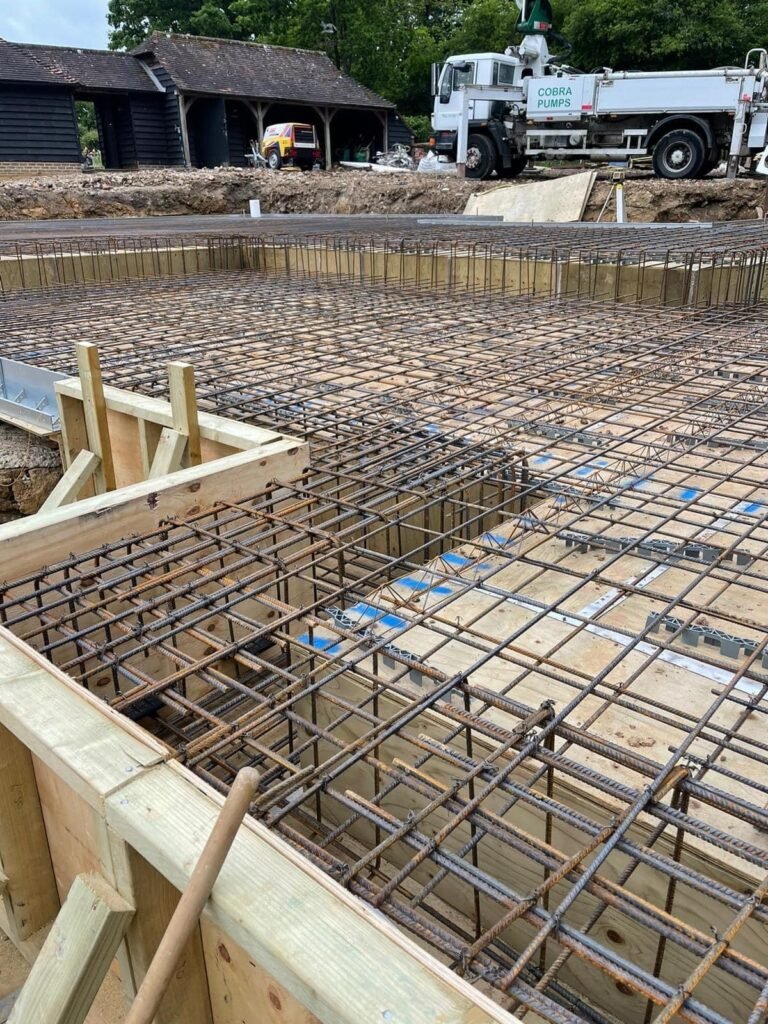
Foundation curing time is the duration it takes for the concrete used in the foundation to harden and gain its full strength. During this process, the concrete undergoes a chemical reaction called hydration, where water and cement particles combine to form a solid mass. This solidification process is essential for the foundation to achieve its desired strength and stability.
The curing time is essential and must be adhered to strictly to ensure that the base is strong enough to support the building’s loads. Therefore, it is essential to get the construction base right by following the recommended guidelines, undergoing necessary inspections, and being patient during the curing process.
Recommended waiting time for different construction base types is critical in ensuring that the construction base is strong enough to support the building’s loads. The curing time can vary depending on the type of construction base used, the ground profile, and the loads of the building. For instance, a concrete base will require at least 7 days of curing time per inch of thickness.
However, in colder weather, the curing time will be extended. Meanwhile, the waiting time for strip construction base is typically around 7 days, while raft construction base will need at least 14 days (about 2 weeks) to cure properly. When building on clay soil, the waiting time may need to be extended to allow the soil to settle, and the construction base to adjust. Self-builders must also understand the recommended waiting time for different construction base types and ensure that they adhere to it.
It is essential to get the construction base right by following the recommended guidelines, undergoing necessary inspections, and allowing sufficient curing time for the base to be strong enough to support the building’s loads.
Building on an insufficiently cured base can have severe consequences for the building’s stability and longevity. Insufficient curing time can result in weaker concrete, which can compromise the building regulation’s ability to support the building’s loads. This can lead to structural damage, cracking, and even collapse. Moreover, building on an unstable base can cause the building to settle or shift, resulting in further damage to the structure.
Repairing such damage can be expensive and time-consuming, leading to significant disruptions to the building’s occupants. Also, building control regulations require builders to adhere to the recommended curing time for different ground support materials. Non-compliance with these regulations can lead to legal penalties and additional costs to correct any defects.
Therefore, it is crucial to prioritise the curing time and adhere to the recommended guidelines to ensure that the foundation is strong enough to support the building’s loads and the building are safe and durable.
Best practices for ensuring proper ground support curing are essential for any construction company in the UK to follow. One of the key practices is to ensure that the ground support is deep enough, with stable ground and proper drainage to prevent moisture from affecting the curing process. A step-by-step guide should be followed, starting with marking lines to indicate where to dig the foundation trenches.
After excavation is complete, shuttering reinforced with timber should be used to create a right-angled slab, which should then be saturated with concrete. It is crucial to ensure that the concrete is poured and pouted correctly to avoid air pockets, which can weaken the concrete’s strength. Building regulations will then examine and ensure that the ground support is level using a spirit level.
The recommended curing time for different ground support types should be followed, allowing sufficient time for the concrete to attain its full strength and stability. Additionally, it is essential to examine the ground support periodically during the curing process to identify any defects early and correct them. Following these best practices ensures that the ground support is strong enough to support the building’s loads and that the building is safe, durable, and up to building regulations.
Expert advice on construction base curing time is critical for construction companies in the UK to ensure that the building’s construction base is strong enough to support the loads. Builders need to know that different construction base types have different recommended curing times, and these times can be affected by external factors such as temperature, humidity, and ground profile.
It is essential to follow a step-by-step guide to ensure that the construction base is deep enough, with stable ground and proper drainage. Shuttering reinforced with timber should be used to create a right-angled basement slab that is saturated with concrete. Builders need to ensure that the concrete is poured and pouted correctly to avoid air pockets, which can weaken the concrete’s strength. Building control regulations require builders to adhere to the recommended curing time for different construction base types. Builders need to be patient during the curing process, and it is essential to examine the construction base periodically to identify any defects early and correct them.
Expert advice recommends allowing additional curing time if there is any doubt about the construction base’s stability. By following these expert recommendations, builders can ensure that the construction base is strong enough to support the building’s loads, and the building is safe, durable, and up to building regulations.
Real-life examples of how long it takes to leave construction base before building in the UK can help construction companies better understand the importance of construction base curing time. For instance, in one case, a builder in the UK failed to wait for the recommended curing time for a concrete footing, resulting in the floor of the building sinking and causing significant structural damage.
The builder had to remove the entire construction base and start again, leading to costly repairs and project delays. Another example involved a self-build project where the builder did not wait for the recommended curing time for the foundation and started building the walls, resulting in the walls cracking and the building being deemed unsafe. The builder had to remove the damaged walls and wait for the construction base to cure before restarting the project, resulting in additional costs and time delays.
These real-life examples highlight the importance of adhering to the recommended curing time for different footing types to ensure that the building is safe, durable, and up to building regulations standards.
Frequently asked questions about construction base curing time in construction are common among builders in the UK. One frequently asked question is how long to wait before building on a construction base. The answer varies depending on the type of construction base used, the ground conditions, and the loads of the building. Another common question is whether it is possible to speed up the curing time.
While there are ways to accelerate the curing process, such as using accelerators or applying heat, it is crucial to follow the recommended curing time to ensure that the construction base is strong enough to support the building’s loads. Additionally, builders often ask about the consequences of building a house on an insufficiently cured construction base. Building on a construction base that has not been cured properly can compromise the stability and longevity of the building and can result in costly repairs and safety hazards.
Therefore, it is essential to adhere to the recommended curing time for different construction base types and to allow sufficient time for the construction base to cure properly. By following these guidelines and getting expert advice, builders can ensure that the construction base is strong enough to support the building’s loads and that the building is safe, durable, and up to building regulations
Prioritising construction base curing time is crucial for any construction company in the UK to ensure safe and durable buildings. Building on insufficiently cured construction base can compromise the stability and longevity of the building, resulting in costly repairs and safety hazards.
It is essential to follow a step-by-step guide when building construction base, starting with marking lines to indicate where to dig the construction base trenches, shuttering reinforced with timber, creating a right-angled slab filled with concrete, and ensuring the flooring and construction base is level using a spirit level.
The recommended curing time for different construction base types should be followed, allowing sufficient time for the concrete to attain their full strength and stability. Building control regulations require builders to adhere to the recommended curing time for different construction base types, and non-compliance can lead to legal penalties and additional costs to correct any defects.
Therefore, it is crucial for construction companies to prioritise the curing time, get expert advice, and adhere to the recommended guidelines to ensure that the construction base is strong enough to support the building’s loads and that the building is safe, durable, and up to building regulations standards.
The curing time of a foundation is crucial for several reasons:
- Strength and Stability: Proper curing allows the concrete to develop its maximum strength, ensuring the foundation can withstand the load it will bear throughout its lifespan. Insufficient curing time can result in a weaker foundation, leading to structural issues and potential safety hazards.
- Crack Prevention: Adequate curing time helps minimize the formation of cracks in the foundation. When concrete cures too quickly, it may shrink and crack, compromising its integrity. By allowing the concrete to cure at the appropriate pace, the risk of cracks is significantly reduced.
- Moisture Retention: During the curing process, it is crucial to maintain the right level of moisture in the concrete. This moisture helps the chemical reaction continue, promoting the development of strength. Proper moisture retention is especially important in the UK, where weather conditions can be unpredictable.
- Longevity: A well-cured foundation has a longer lifespan. By allowing the concrete to cure properly, you are ensuring the foundation’s durability and minimizing the need for future repairs or replacements.
Several factors influence the duration of foundation curing time:
- Weather Conditions: In the UK, where weather can be unpredictable, it is essential to consider the impact of temperature, humidity, and precipitation on the curing process. Extreme temperatures or excessive moisture can negatively affect the curing time and the quality of the foundation.
- Type of Concrete: The composition of the concrete mixture used in the foundation can also affect the curing time. Different types of cement and aggregate combinations may have varying curing requirements.
- Foundation Design: The size, shape, and complexity of the foundation can influence the curing time. Thicker foundations or those with intricate designs may require longer curing periods to ensure proper strength development.
- Curing Methods: There are various methods for curing concrete, including wet curing, membrane curing, and curing compounds. Each method has its own curing time requirements and considerations.
Understanding the importance of foundation curing time is crucial for ensuring the strength, stability, and longevity of any building. By allowing the foundation to cure properly, you are investing in the structural integrity of your construction project. Remember to consider the various factors that can affect the curing time and consult with experts to ensure the best outcomes for your foundation in the UK.
Foundations for the Empire State Building?
The Empire State Building, standing tall and proud in the heart of New York City, is an iconic landmark that has captivated people around the world for
Why building foundations are necessary?
Foundations are the bedrock of any building, be it a humble house or towering high-rise buildings. They have the vital job of transferring the entire weight
The perfect concrete pour for your construction project
We will discuss the dos and don’ts of concreting for your next construction project, covering aspects such as the concrete mix, pouring, curing process
What is a raft foundation?
Raft foundations are a popular choice for many construction projects, providing a stable and durable base for buildings. Explore the benefits of raft foundations, the construction process
What is a building foundation?
A building foundation is the lowermost part of a structure that is in direct contact with the ground. It is designed to distribute the weight of the building evenly and transfer it to the underlying soil or rock.
Types of building foundations
This article discusses the different types of building foundations in the UK, including strip foundations, raft foundations, piled foundations, trenchfill foundations, pad foundations, caisson foundations
How long do foundations take to cure?
A step-by-step guide is required, starting with marking lines to indicate where to dig the foundations trenches. After landscaping, shuttering, reinforced with timber, must be used
How to set out building foundations
Setting out the building foundations of a construction project is a critical stage, and it requires the use of specialised tools and materials. In the UK, the most common tools
How deep do building foundations need to be?
Building foundations are a critical component of any construction project in the UK, and it is important to ensure that they are constructed to the required depth.
Foundation building regulations
The regulations are designed to ensure that construction projects are structurally sound and meet certain safety standards. This includes the use of appropriate foundation systems
What is a building slab?
Building slabs are an essential component of construction projects in the UK. They provide a solid and stable foundation for structures, distributing the weight evenly across the ground. This article discusses the types of building slabs commonly
Why building foundations fail?
Understanding the factors that contribute to building foundation failures in the UK, such as soil conditions, poor drainage, tree roots, construction errors, subsidence, and the age of buildings.
Ready to start your project?
Let's Work Together
To get started, for general enquiries simply complete the form below. Provide us with your project details, and our team will review your requirements. We will then get back to you with a customised solution that fits your needs. Whether you have a small-scale project or a large-scale development, we have the expertise and resources to handle it. Once we have received your submission, you will receive a confirmation email (Please check all your email boxes)
If you prefer, and have a project in mind and seeking a price you can also send us your project documents and any photographs directly to Price@totalregen.co.uk. We will carefully examine your documents and provide you with a competitive quote together with a timescale from inception through to completion for your project.


